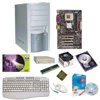 As you install and run more software on your computer, over time, the computer will start to run more slowly. This happens because the additional software is making greater demands from your hardware. You can address the problem by either reducing the software or increasing your hardware resources.
As you install and run more software on your computer, over time, the computer will start to run more slowly. This happens because the additional software is making greater demands from your hardware. You can address the problem by either reducing the software or increasing your hardware resources.If you decide to upgrade your hardware, there are 3 parts of your computer that can be upgraded to improve your PC speed: the RAM memory, your disk drive and the CPU+motherboard combo.
Upgrading your RAM or a disk drive is easy and you can do it yourself, in a few simple steps. Upgrading your CPU is difficult and involves replacing the whole motherboard. I would not recommend upgrading your CPU, yourself, unless you know what you are doing.
Upgrading your RAM
Dollar for dollar, increasing your PC's RAM is the best value for money upgrade you can perform. Right now I would recommend having 1 Gig of RAM for low end machines, 2Gig for middle of the road machines and 3 Gig for high end computers. You are unlikely to benefit from having more than 3 Gig.
You can tell how much RAM you currently have installed, in Windows XP and Vista, by opening the control panel and going into the system section.
There are a number of different types of RAM and they operate at different speeds. RAM speed is measured in MHz. The type of RAM and the speed that is allowed is determined by your motherboard. You can look up the type and speed of RAM you can use in your motherboard manual. I recommend getting the highest speed RAM allowed.
Open the computer tower and locate the RAM slots there could be 2-4 slots, if you don't see them check your motherboard manual. After locating the nearest available Slot simply insert the new module into the slot, taking careful note of the groves on the DIMM and the Locking clip to position the Module properly. If the DIMM does not fit you probably have it positioned incorrectly so flip it around and try reinserting it. Once the RAM module is in place apply pressure to the locking clips to secure it, you should hear a click as they close on the DIMM. Then just re-start your PC, go to the control panel and open the system section to ensure your computer has detected the new DIMM and it is working correctly.
Upgrading your hard drive
Hard drive speed is measured in RPM, that is the number of times the hard drive rotates in one minute. I recommend buying a 7,200 RPM hard drive. Before purchasing a new hard drive consult your motherboard guide to find out what type of hard drives are supported. If your motherboard supports SATA drives, buy one of those.
Once you have purchased your new hard drive it is time to prepare for the install. First install any software that came with your drive. Then power down the computer and open the case.
Setting jumpers (This is only for IDE hard drives):
The different jumper settings will be shown on a diagram on top of the hard drive. If you have one drive that drive should be set to the single drive mode. If you have multiple drives, the one drive needs to be set to master and the rest of them to the slave mode.
Insert your new drive in an open drive bay. These bays are generally located in the front of the tower. Fix the drive in place with screws.
Look at both your mother board and drive manual and connect the drive using the relevant IDE or SATA cables.
Now that the hard work is done the only thing left to do is close back up your system, plug it in, and turn it on to verify that the new hard drive is working properly.

0 comments:
Post a Comment